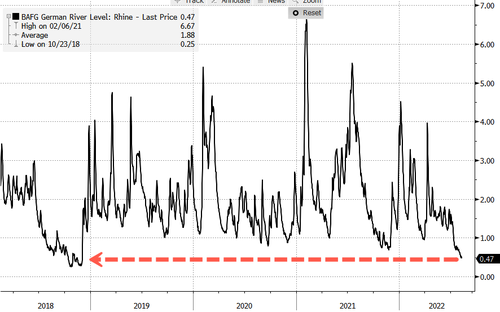Germany’s Industrial Heartland Faces Crisis As Rhine River May Become Impassable By Friday
Water levels on the Rhine River are nearing dangerously low levels, and new forecasts expect Europe’s most critical waterway for inland commodity shipments via barges could be impassable by the end of the week.
The river at Kaub, Germany, is 47 centimeters (18.5 inches) on Wednesday and is expected to drop to the critical depth of 40 centimeters (15.7 inches) by Friday, according to the German Federal Waterways and Shipping Administration. There is even the possibility water levels could fall as low as 37 centimeters (14.5 inches) during the weekend.
Below 40 centimeters would mean barges at the key transit point in Germany would no longer be able to pass and restrict shipments of energy products and other commodities along Europe’s most crucial waterway amid the worst energy shortage in decades.
In the next couple of days, if forecasts are correct, Germany’s industrial heartland may risk a repeat of the disruption seen during the river’s historical low in 2018. Rhine River becoming impassible would certainly exacerbate Europe’s ongoing energy crisis.
The Rhine snakes about 800 miles (1,300 kilometers) from the Swiss Alps through Europe’s largest industrial areas and has already dented cargo shipments for chemicals giant BASF SE, steelmaker ThyssenKrupp AG, and utility Uniper SE. Bloomberg lists the most exposed companies to low Rhine River levels:
Uniper warned low water levels have reduced barge coal shipments to a major power plant. The utility said its 510-megawatt Staudinger-5 coal-fired power plant had seen fewer and fewer barge shipments of coal due to dwindling low water levels that could soon result in “irregular operation.”
Bloomberg outlines the most transported goods on the waterway. If water levels fall below 40 centimeters, companies must use rail and trucking for transportation.
As much as 10% of Europe’s chemical shipments utilize the Rhine River, including feedstocks, fertilizers, intermediates and finished chemical products. The Rhine accounts for about 28% of chemical shipments in Germany, based on our analysis of 2019 and 2020 transport data. The nation is the heart of Europe’s chemical industry, accounting for 36% of EU production over the past decade by tonnage.
Industrial gases, many of which move by pipeline or truck, are excluded from this analysis, which includes data from Eurostat, The Central Commission for the Navigation of the Rhine, and Verband der Chemischen Industrie. Key publicly listed producers with facilities along or near the Rhine include BASF, Wacker, EMS-Chemie, DSM, Umicore, Akzo-Nobel and Celanese. -Bloomberg
Top commodities shipped via barge on the river.
Low water levels on the Rhine are set to unleash unwanted and additional supply-chain issues for the EU’s largest economy as the persisting energy crisis may spark economic hell by winter.
Tyler Durden
Wed, 08/10/2022 – 09:37

